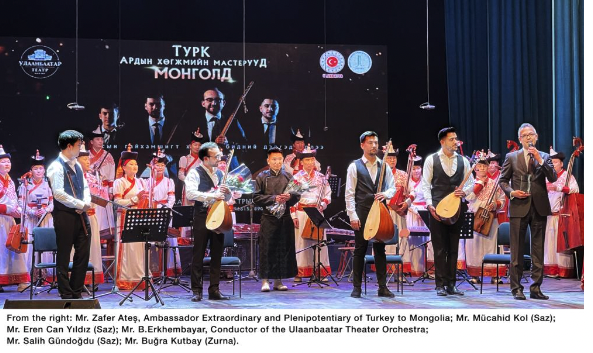The two bounds of Central Asia came together as traditional Turkish and Mongolian music wove a wreath of folk songs across time and distance last week at the Ulaanbaatar Theater. The crescent moon and its vibrant star reflected in the enchanting tunes of the saz – a long-necked lute – and the zurna – a woodwind instrument – against the background of the eternal blue sky.
Four folk music masters – Salih Gündoğdu, Eren Can Yıldız, Mücahid Kol, and Buğra Kutbay – from the Turkish capital, Ankara, in collaboration with the Ulaanbaatar Theater music ensemble, immersed the audience in an enthralling concert. The program consisted of lyrical and rhythmic Turkish traditional melodies played in the first half and lively Mongolian traditional music and dance performed in the second half. The evening ended on a spirited note with an arrangement of R. Bat-Erdene’s Mongolian contemporary classical piece, “The Gallop of Approaching Steeds,” by Ulaanbaatar Theater composer O. Chinbat for the Turkish quartet as the lead.

Palpable in the music was the nomadic spirit that upholds adaptability to change and reverence for freedom and nature as the traditional guiding principles in these cultures that emerged from nomadic roots. They are reflected in shared values such as efficacy in action and religious tolerance. Both Turkish and Mongolian folk melodies speak to the essential presence of nature in the impermanence of life.
The Sky Turks inhabited the land of the eternal blue sky between the 6th and 8th centuries AD and carved the first written use of the name Turk in ancient Turkic runes onto the Tonyukuk stone from the 8th century, located in the Tuul river valley.1 They worshiped Tengri, who symbolized the universe and its laws. This was the same Tenger deified five centuries later by Chinggis Khaan, the founder of the Mongol State. As two of the numerous steppe tribes to have originated in Mongolia, the Turkic and Mongol nomadic empires had a great influence on one another throughout various periods in history.
The Turkish musical scale called Makam Ussak is remarkably unique.2 It has more tonal variations in between notes than classical Western and Eastern harmonies. These microtones tend to make Turkish music sound sharper and higher in resonance by comparison to well-known Middle Eastern harmonies. Thus, the versatility of the tonal variations in Turkish traditional music carries a special expression of the richness in natural landscapes and cultural diversity that Turkey is blessed with thanks to its unique geographical location.
It is interesting to note that in the 13th century, the Mongol armies employed the beats of shamanic drums to prepare for battle.3 War drums were part of the Mongol military tactic to frighten the enemy from a distance before the start of a conquest.4 From the 14th century onward, the elite military forces of the Ottoman Empire refined the tactic into an entire art form. The Janissaries and their battle marches became so legendary that in the 18th century, their beats and rhythm inspired W. A. Mozart to write one of the evergreen favorites of classical music, the third movement of Sonata No. 11, better known as “The Turkish March.”
As Turkish and Mongolian musicians united in retelling the tales of brotherhood through music that evening, the crescent moon and its star shone brightly in the eternal blue sky. It was as though their songs soothed the souls and uplifted the spirits of listeners and wove a wreath of marvelous beauty across time and distance over the steppes of our ancestors.
References:
1. Weatherford, Jack. Genghis Khan and the Quest for God. New York: Penguin Books, 2016. (Chp. 3)
2. “The Difference Between Quartertones in Persian, Arabic, and Turkish Music.” YouTube, uploaded by OudforGuitarists, 16 May 2015, https://youtu.be/YCVFkircZUg. Accessed 10 April 2022.
3. Kappler, Claude-Claire et René. Guillaume de Rubrouck, Envoyé de Saint Louis: Voyage dans l’Empire mongol (1253-1255). Paris: Payot, 1985. (Chp. 35, Note 11)
4. Rustichello of Pisa. The Travels of Marco Polo, Vol. 1. Scotland: Yule-Cordier, 1902. (Book 2, Chp. 4, Note 3)
5. “The Differences and Similarities between Turkish and Western Music.” YouTube, uploaded by Atesh Electric, 16 October 2020, https://youtu.be/s4h0NdnOGQY. Accessed 10 April 2022.
6. Kultur Yasam. “11 Instruments Used in Turkish Music.” https://kulturveyasam.com/turk-muziginde-kullanilan-11-calgi/?fbclid=IwAR2hluVxYLKqyAY5K0cFOiFrpqaFsS48TOpi3lxFaFpjYvDwInDvNcCw4l8. Accessed 10 April 2022.
By Ariunaa Jargalsaikhan
Published in UB Post on April 15, 2022
Ulaanbaatar








